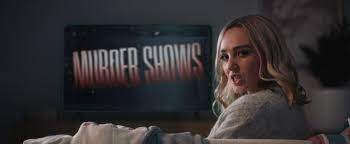"20/20’s: Sole Survivor” is the Imperfectest True Crime Show to Fall Asleep To
True crime media is notoriously obsessed with the “missing white woman” trope, and yet the vast majority of American murder victims are male, and well over half are people of color.
Acree Graham Macam, Incluvie Guest Columnist on how “murder shows” like 20/20’s “Sole Survivor” and other true crime stories could just be the Millennial’s solution for anxiety…even SNL agrees.
_____________________________________________________________________
I can’t sleep.
I’m 72 hours into the first nine-day residency of my MFA, and—after a weekend of 13-hour programming, making a dozen new friends, and agonizing about what they all think of the novel excerpt I sent them, I’m lying in bed, struggling to turn off my brain. I worry about all the dumb things I said today in workshop. I worry about how large and visible my pregnant belly is, and if people think it’s foolish of me to be here, starting a grad program, instead of at home, waiting for my baby to be born. I worry about my three-year-old and her dad, if she’s eating enough vegetables, and if the plane they’ll take in a few days to meet me is the Boeing 737 MAX that killed hundreds of passengers in crashes.
So, what does a Millennial do to ease her everyday anxieties? She watches a “murder show”…about serial killers.

As a society, we’ve been obsessed with serial murderers for centuries. But in the past few years, the popularity of true crime media has skyrocketed. In 2022, Netflix’s docudrama about serial killer Jeffrey Dahmer became one of their top-streamed shows of all time. Between 2018 and 2021, the number of documentary series on streaming services grew by 63%, while demand for it grew by 142%. Of those documentaries, true crime was the largest—and fastest growing—segment.
Of course, the popular portrayal of murder rarely matches the reality. True crime media is notoriously obsessed with the “missing white woman” trope, and yet the vast majority of American murder victims are male, and well over half are people of color. When women are killed, it’s much more likely to be by an intimate partner than a random maniac on the street. (Less than one percent of all murders are committed by serial killers.) And yet, tomorrow, when I walk across a dark parking lot alone, I will lace my fingers around my car key like a shiv.
Better the devil you know than the one you don’t.
Tonight, I’m staying in a hotel room with a 500-channel cable package. And so, like in every hotel stay in living memory, I search the guide for that early 2000s true crime classic, Forensic Files. To my disappointment, Forensic Files is not playing on any of the half-dozen exclusively true crime cable channels. Instead, Evil Lives Here, Murder Comes to Town, Murdered By Morning, Snapped, Signs of a Psychopath, and, of course, the ABC newsmagazine program, 20/20, are my options.

When I was in eighth grade, there was no higher standard of journalism than 20/20. I stayed up late Saturday nights, after the newepisodes of Clarissa Explains It All and Are You Afraid of the Dark? ended (and all the other 14-year-olds in America had shuffled off to bed), and I watched Hugh Downs and Barbara Walters tackle the issues of the day. In 1999, these consisted of stranger danger, the ongoing debate over “ebonics,” and Y2K. At the end of each episode, John Stossel complained about trivial societal ills like the inexact cost of candy bars. “$2.99? Why can’t they just make it three dollars?”
Today, 20/20 seems primarily focused on true crime. I don’t know if this is an attempt to compete with rival network NBC’s Dateline, but it feels like one. And—with all due respect to the memory of Hugh and Barbara—a bit of a weak one at that. Did you know you can buy a Christmas tree ornament with Dateline host Andrea Canning’s face on it? Did you know you can have Keith Morrison narrate your Waze directions? Did you know that a popular true crime podcast chronicles Josh Mankiewicz’s accessories in a segment entitled “Manky’s Hankies”?

According to Google, 20/20 consistently beats Dateline’s Friday night ratings. Perhaps we can therefore think of Dateline as the literary newsmagazine show.
I digress.
It seems 20/20 perfectly evolved over the years to sync with my changing interests. However, 20/20 is no Dateline. And Amy Robach is no Barbara Walters.
In this episode (season 42, episode 2: “Sole Survivor”), the show follows a woman who, at 15, learns her biological mother was a victim of serial killer John Robinson. And that her uncle is that killer.
If only the show could put things so succinctly. Instead, the timeline jumps around like an experimental novel, flashing montages and soundbites of the exciting moments to come, before cutting to commercial. Following the commercial break, it summarizes the montages and soundbites we were just shown moments before. Then: another commercial break. When the show finally pauses to tell the story, it depends almost entirely on interview clips where speakers discuss key players using vague, ill-defined pronouns. “What?!” I find myself yelling at the TV. “Who?!”
And, in classic true crime fashion, the show seems focused almost exclusively on the white victims of John Robinson, giving only brief moments of airtime to the victims of color.
In one scene, a 20/20 producer and the serial killer victim’s daughter stop at the site of a former Rodeway Inn, where the mother is believed to have been killed. The motel has been razed, the lot overgrown with weeds. The daughter quietly collects a few grasses into her empty water bottle as mementos.

“Whatcha doing, Heather?” the producer asks in a tone befitting a bowling alley.
“Getting some dirt,” the daughter answers, looking disappointed at the lameness of her own response.[1] How I long for Keith Morrison to swoop in, with his gentle, compassionate frowns and his simple, understated responses that leave room for the unsaid. When Keith Morrison exploits someone’s personal tragedy for entertainment, it feels less exploitative somehow.

Of course, I could cut the show off at any time. I could slip my laptop out of my bag, navigate to one of the dozen streaming services I pay for, and watch some prestige docudrama: Netflix’s Dahmer, maybe. Or better yet, Forensic Files. But opening my laptop would break that special reverie that hotel cable provides … casting its blue glow over the white sheets of my rented king-size bed.
By the time I manage to piece together what this episode of 20/20 is actually about, it’s nearly over. The next thing I know, my eyes blink awake, to another story on the television: some poor girl kidnapped in the nineties. Some poor girl who would be my age now, had she lived. With that thought, I turn off the TV, pull my sleep mask over my eyes, and drift easily back into dreamland.
It doesn’t matter that I missed how John Robinson was apprehended and convicted. I’ve seen enough of these series to know that he was. And so, the convenient procedural magic trick of true crime has done its work on my brain: turning one small story of justice into the feeling that a larger resolution has taken place.
For a moment, I can forget that hundreds of thousands of people are murdered every year, and that John Robinson was the perpetrator of just a few of those murders, a long time ago. I can forget that someone, somewhere in the world, is probably being murdered right now—and that’s not even accounting for state-sanctioned violence. I can forget that John Robinson wasn’t the one who built the 737 MAX and lied to the public about its safety when it crashed not once, but twice. I can forget that the larger, systemic issues of poverty and racism and gun violence and corporate greed and how to get a toddler to eat eggplant have yet to be solved—and may never be. Because tonight, in my hotel room, the villain of the moment is captured behind a 42-inch flat screen. And the rest, it seems, can wait till tomorrow.
So I sleep, proving that true crime media is a powerful sedative. One it could be easy not to wake up from.

Guest Columnist Acree Graham Macam (she/her) is a Stonecoast MFA candidate and the author of the picture book, The King of the Birds (Groundwood, 2016), inspired by the life of Flannery O’Connor. An ambivalent true crime fanatic, she lives with her spouse and two young children on Atlanta’s east side.
More to explore
By Same Author
Related lists created by the same author
By Cluvie Category
Related diversity category
It Goes all the Way to the Top: Motherless Brooklyn
'Motherless Brooklyn' is a 1950s whodunit made by its star, Edward Norton. Like most detective films in this setting, the cast is mostly white males (with a few notable exceptions).
By General Category
Related movie/TV/List/Topic
No Problem with 'Beef'
"Beef" is a new dark comedy with a near entire Asian-American cast





